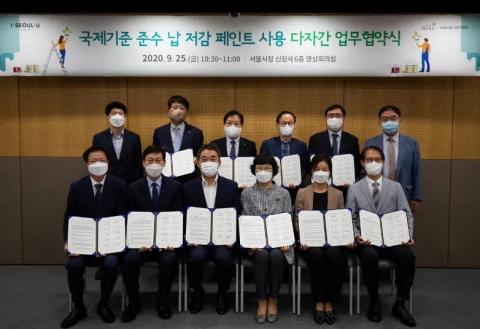South Korea to require lead-safe paints in Seoul city-managed facilities and public places

Read the original press release from the Network for a Carcinogen-Free Society and IPEN in Korean
On September 25, 2020, the Seoul Metropolitan Government announced that it would sign a “multilateral agreement on the use of lead-reducing paint that complies with international standards”. The main focus is to use products with excellent safety and low lead content below the recommended level of the World Health Organization (WHO) in city-managed facilities and public places. The agreement includes five paint manufacturers, the Korea Paint Ink Industry Cooperative, Seoul Facilities Corporation, SH Corporation, and the Green Seoul Citizens' Committee. This is a valuable fruit of civil society organizations that have been working for a safe environment for children from harmful substances, paint manufacturers that manufacture safe products, and Seoul's efforts to make Seoul safe from harmful substances.
According to the Seoul Metropolitan Government, through this agreement, less than 0.009% (90ppm) lead in the interior and exterior of public facilities managed by the Seoul Facilities Corporation and public housing sold, rented, and managed by the Seoul Housing and Urban Corporation (SH) comply with international standards. Only paints containing this will be used.
85.7 million children, or 50% of the world's children, are at risk of lead poisoning. Lead is a representative harmful heavy metal that affects brain development in children and causes abnormal behavior. In addition, in adults, continuous exposure to lead causes cardiovascular disease, with 674,000 deaths annually. 70% of countries around the world do not have an overall lead regulation.85.7 million children, or 50% of the world's children, are at risk of lead poisoning. Lead is a representative harmful heavy metal that affects brain development in children and causes abnormal behavior. In addition, in adults, continuous exposure to lead causes cardiovascular disease, with 674,000 deaths annually. 70% of countries around the world do not have an overall lead regulation.
The domestic lead regulation is 90ppm or less for children's products and 600ppm or less for children's activities, but there is no lead regulation standard that applies to all-purpose paints. Compared to the international paint lead content standard of 90ppm, the domestic paint lead regulation falls short of this. Europe and the United States, as well as China, Russia, India, Indonesia, the Philippines, Kenya, Mexico, and Argentina have set the international paint lead content standard of 90ppm as domestic regulation.
The multilateral agreement of Seoul's “Use of lead-reducing paint that complies with international standards” will be a milestone in making Korean society a safe society from lead. Considering the city's status and population density, it seems difficult for paint manufacturers to manufacture Seoul paint and other paints separately. Through this agreement, Korean society will take a step forward in using paints that comply with international lead content standards.
However, there are still challenges to be solved. Since the Seoul Metropolitan Government Convention is a voluntary agreement, domestic paint law regulations that apply international lead content standards must be established. Civil society organizations that have been striving to create a society that is safe from children's health and harmful substances will make more efforts to amend the relevant laws in the future.
